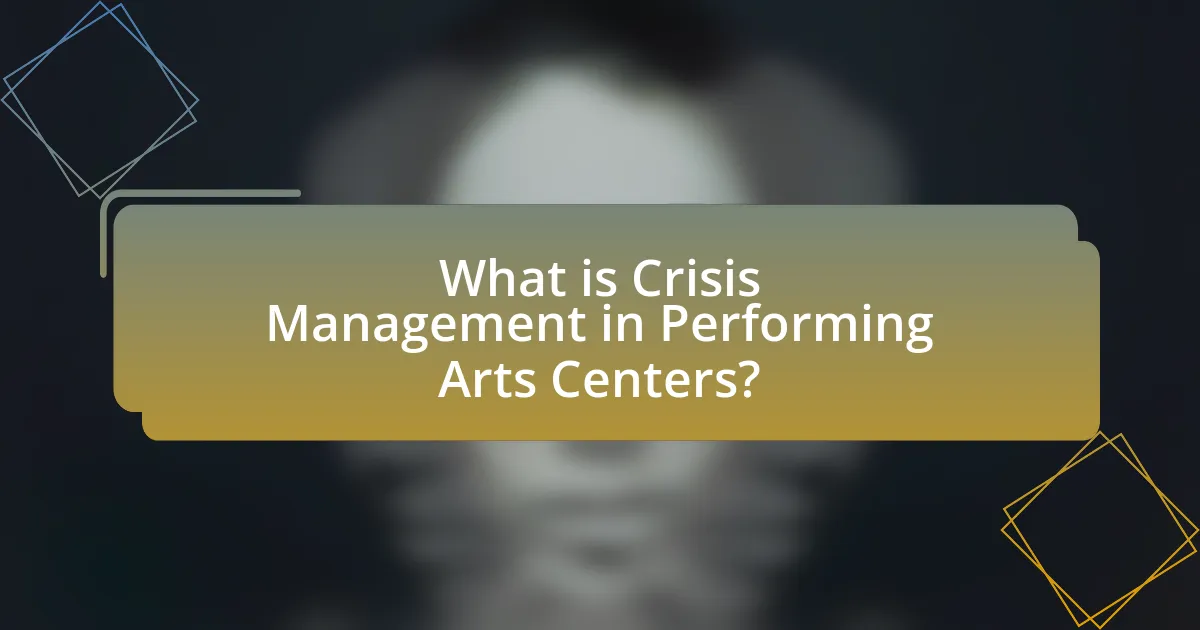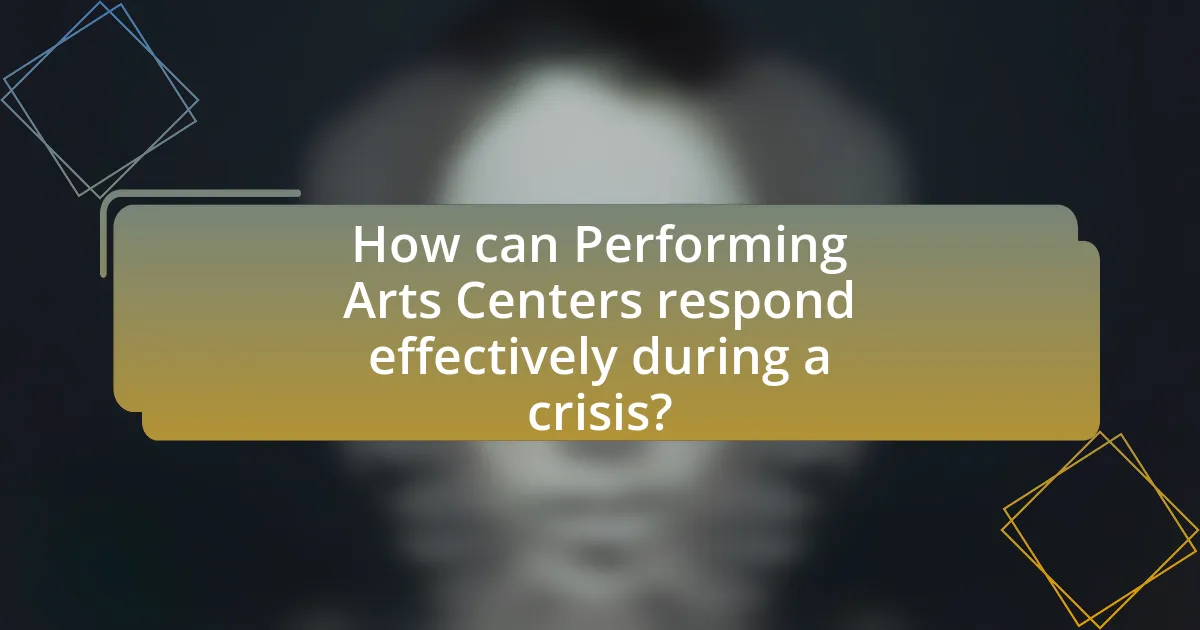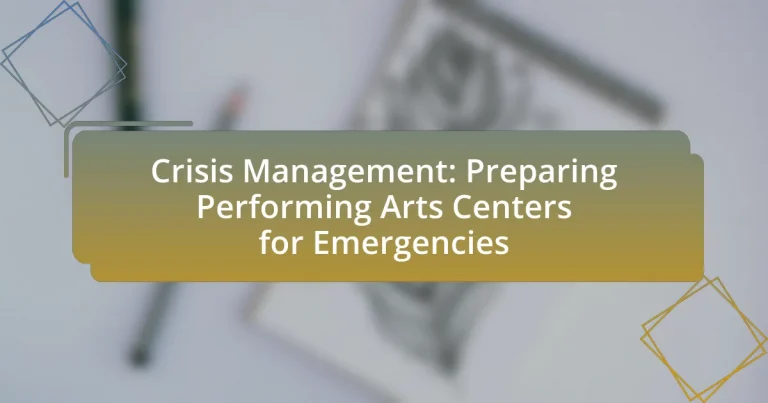Crisis management in performing arts centers involves a systematic approach to preparing for, responding to, and recovering from emergencies that threaten the safety of patrons and staff. The article outlines the importance of effective crisis management protocols, which include risk assessments, emergency response plans, and staff training to handle various crises such as natural disasters, security threats, and health emergencies. It discusses the impact of crises on operations, the key components of a crisis management plan, and the roles of staff in executing these plans. Additionally, the article highlights the significance of communication strategies, partnerships with local emergency services, and the use of technology in enhancing preparedness and response efforts. Finally, it addresses best practices for post-crisis recovery and rebuilding trust within the community.

What is Crisis Management in Performing Arts Centers?
Crisis management in performing arts centers refers to the systematic approach to preparing for, responding to, and recovering from emergencies that may disrupt operations or threaten the safety of patrons and staff. This includes developing emergency response plans, conducting risk assessments, and training staff to handle various crisis scenarios, such as natural disasters, security threats, or health emergencies. Effective crisis management is essential for ensuring the safety of attendees and maintaining the operational integrity of the venue, as evidenced by the implementation of protocols in response to incidents like the 2017 Manchester Arena bombing, which highlighted the need for enhanced security measures in public venues.
Why is Crisis Management important for Performing Arts Centers?
Crisis management is important for performing arts centers because it ensures the safety of patrons, staff, and performers during emergencies. Effective crisis management protocols help mitigate risks associated with various threats, such as natural disasters, security breaches, or health emergencies. For instance, the National Fire Protection Association emphasizes that venues must have emergency plans in place to protect lives and property, highlighting the necessity of preparedness in high-traffic environments like performing arts centers. By implementing structured crisis management strategies, these centers can maintain operational continuity and safeguard their reputation, ultimately fostering a secure environment for cultural engagement.
What types of crises can affect Performing Arts Centers?
Performing Arts Centers can be affected by various types of crises, including natural disasters, health emergencies, financial crises, and security threats. Natural disasters such as earthquakes, floods, or hurricanes can cause significant physical damage and disrupt operations. Health emergencies, exemplified by the COVID-19 pandemic, can lead to closures and reduced audience attendance, impacting revenue. Financial crises may arise from mismanagement or economic downturns, jeopardizing the center’s sustainability. Security threats, including terrorism or violence, can create immediate safety concerns and necessitate emergency response protocols. Each of these crises requires tailored management strategies to mitigate their impact on operations and audience safety.
How can crises impact the operations of Performing Arts Centers?
Crises can significantly disrupt the operations of Performing Arts Centers by leading to cancellations of events, loss of revenue, and increased operational costs. For instance, during the COVID-19 pandemic, many Performing Arts Centers faced prolonged closures, resulting in an estimated $14 billion loss in revenue across the U.S. arts sector. Additionally, crises can strain resources, necessitating emergency protocols and reallocating staff to manage safety measures, which further complicates regular operations. The impact of crises also extends to audience engagement, as fear and uncertainty can deter attendance, thereby affecting future programming and financial stability.
What are the key components of an effective Crisis Management plan?
An effective Crisis Management plan includes key components such as risk assessment, communication strategy, response procedures, and recovery plans. Risk assessment identifies potential crises specific to performing arts centers, such as natural disasters or security threats. A communication strategy ensures timely and accurate information dissemination to stakeholders, including staff, patrons, and emergency services. Response procedures outline specific actions to be taken during a crisis, detailing roles and responsibilities. Recovery plans focus on restoring operations and addressing the aftermath of the crisis, ensuring the center can return to normal functioning efficiently. These components are essential for minimizing impact and ensuring safety during emergencies.
What roles do staff play in Crisis Management?
Staff play critical roles in Crisis Management by executing emergency plans, ensuring safety, and facilitating communication. They are responsible for identifying potential risks, coordinating responses, and providing support to affected individuals. For instance, trained staff members conduct drills to prepare for various scenarios, which enhances overall readiness. Additionally, staff serve as liaisons between management and emergency services, ensuring that accurate information is relayed during a crisis. Their involvement is essential for minimizing chaos and ensuring a swift recovery, as evidenced by studies showing that organizations with well-prepared staff experience significantly reduced response times during emergencies.
How can communication strategies enhance Crisis Management?
Communication strategies enhance crisis management by facilitating timely and accurate information dissemination, which is crucial during emergencies. Effective communication ensures that all stakeholders, including staff, patrons, and emergency responders, receive clear instructions and updates, reducing confusion and panic. For instance, the use of social media and mobile alerts can rapidly inform audiences about safety protocols or evacuation procedures, as demonstrated during the 2017 Manchester Arena bombing, where prompt communication helped manage the situation effectively. Additionally, well-defined communication plans can establish roles and responsibilities, ensuring that messages are consistent and coordinated, which is vital for maintaining public trust and safety during a crisis.

How can Performing Arts Centers prepare for emergencies?
Performing Arts Centers can prepare for emergencies by developing comprehensive emergency response plans that include evacuation procedures, communication strategies, and staff training. These plans should be regularly reviewed and updated to reflect changes in the facility or community risks. For instance, the National Fire Protection Association recommends that venues conduct regular drills to ensure staff are familiar with emergency protocols, which enhances preparedness and response effectiveness. Additionally, establishing partnerships with local emergency services can facilitate coordinated responses during actual emergencies, ensuring that Performing Arts Centers are equipped to handle various crisis scenarios effectively.
What steps should be taken to develop a Crisis Management plan?
To develop a Crisis Management plan, organizations should follow these steps: conduct a risk assessment to identify potential crises, establish a crisis management team with defined roles, create a communication plan for internal and external stakeholders, develop response strategies tailored to specific scenarios, and conduct training and simulations to ensure preparedness.
Conducting a risk assessment involves analyzing vulnerabilities specific to performing arts centers, such as natural disasters or security threats. Establishing a crisis management team ensures that there are designated individuals responsible for decision-making and coordination during a crisis. A communication plan is crucial for maintaining transparency and trust, detailing how information will be disseminated to staff, patrons, and the media. Developing response strategies allows organizations to respond effectively to various crises, minimizing impact. Finally, training and simulations help to reinforce the plan and ensure that all team members are familiar with their roles and responsibilities.
These steps are validated by best practices in crisis management, which emphasize the importance of preparedness and structured response to mitigate risks effectively.
How can risk assessments identify potential crises?
Risk assessments can identify potential crises by systematically evaluating vulnerabilities and threats that may impact an organization. This process involves analyzing various factors such as environmental risks, operational weaknesses, and historical data on past incidents. For instance, a risk assessment may reveal that a performing arts center is susceptible to natural disasters like floods or earthquakes, or it may highlight security vulnerabilities that could lead to safety breaches. By quantifying these risks and prioritizing them based on their likelihood and potential impact, organizations can proactively develop strategies to mitigate these threats. Studies have shown that organizations that conduct regular risk assessments are better prepared for emergencies, as they can implement targeted training and resource allocation to address identified risks effectively.
What training is necessary for staff to handle emergencies?
Staff must undergo comprehensive emergency response training to effectively handle emergencies. This training typically includes first aid and CPR certification, fire safety protocols, evacuation procedures, and crisis communication strategies. According to the Occupational Safety and Health Administration (OSHA), regular drills and scenario-based training enhance staff readiness and ensure familiarity with emergency procedures. Additionally, training should be tailored to specific risks associated with performing arts centers, such as crowd management and dealing with potential threats.
What resources are available for Crisis Management in Performing Arts Centers?
Crisis management resources available for performing arts centers include comprehensive emergency response plans, training programs, and collaboration with local emergency services. Emergency response plans outline procedures for various crises, ensuring staff and audience safety. Training programs, such as those offered by organizations like the National Association of Theatre Owners, equip personnel with skills to handle emergencies effectively. Additionally, partnerships with local police, fire departments, and medical services enhance preparedness and response capabilities, as evidenced by successful crisis interventions in venues across the United States.
How can partnerships with local emergency services improve preparedness?
Partnerships with local emergency services enhance preparedness by facilitating coordinated response strategies and resource sharing. These collaborations enable performing arts centers to develop tailored emergency plans that align with local protocols, ensuring that staff are trained and equipped to handle various crises effectively. For instance, joint training exercises between emergency services and venue staff can improve communication and response times during actual emergencies, as evidenced by studies showing that organizations with established emergency service partnerships report higher levels of readiness and quicker recovery from incidents.
What technology can assist in Crisis Management efforts?
Technology that can assist in Crisis Management efforts includes communication systems, data analytics tools, and emergency management software. Communication systems, such as mass notification systems, enable real-time alerts to staff and patrons during emergencies, ensuring timely information dissemination. Data analytics tools help organizations assess risks and predict potential crises by analyzing historical data and trends. Emergency management software facilitates planning, response coordination, and resource allocation, enhancing overall preparedness. For instance, the use of platforms like Everbridge for mass notifications has proven effective in various emergency scenarios, demonstrating the critical role of technology in crisis management.

How can Performing Arts Centers respond effectively during a crisis?
Performing Arts Centers can respond effectively during a crisis by implementing a comprehensive crisis management plan that includes clear communication, resource allocation, and community engagement. Effective communication ensures that all stakeholders, including staff, artists, and audiences, are informed about safety protocols and updates. For instance, during the COVID-19 pandemic, many centers utilized digital platforms to keep audiences engaged and informed, demonstrating adaptability. Resource allocation involves assessing and deploying necessary resources, such as financial support for staff and artists, which is crucial for maintaining operations. Community engagement fosters collaboration with local authorities and health organizations, enhancing the center’s ability to respond to emergencies. Research indicates that organizations with established crisis management frameworks are better equipped to navigate challenges, as seen in the National Arts Strategies report, which highlights the importance of preparedness in the arts sector.
What immediate actions should be taken during a crisis?
During a crisis, immediate actions should include activating the emergency response plan, ensuring the safety of all individuals present, and communicating clearly with staff and emergency services. Activating the emergency response plan allows for a structured approach to managing the situation, while ensuring safety prioritizes the well-being of attendees and staff. Clear communication is essential for coordinating efforts and providing accurate information to those affected. According to the National Fire Protection Association, having a well-defined emergency response plan can significantly reduce chaos and improve outcomes during crises in public venues.
How can effective communication mitigate panic during a crisis?
Effective communication mitigates panic during a crisis by providing clear, accurate information that helps individuals understand the situation and their options. When people receive timely updates and instructions, they are less likely to feel overwhelmed or confused, which can lead to panic. Research indicates that during emergencies, effective communication reduces anxiety and fosters a sense of control among affected individuals. For example, the Federal Emergency Management Agency (FEMA) emphasizes that clear messaging can significantly improve public response and compliance during crises, thereby minimizing chaos and panic.
What protocols should be followed for evacuations or lockdowns?
Evacuations and lockdowns should follow established protocols that prioritize safety and efficiency. During an evacuation, individuals must be instructed to leave the premises quickly and calmly, using designated exits while avoiding elevators. Staff should conduct headcounts to ensure everyone is accounted for. In a lockdown situation, individuals should secure themselves in a room, lock doors, turn off lights, and remain quiet until authorities declare the situation safe. These protocols are supported by guidelines from organizations such as the Federal Emergency Management Agency (FEMA) and the National Fire Protection Association (NFPA), which emphasize the importance of clear communication and training in emergency preparedness.
What are the best practices for post-crisis recovery?
The best practices for post-crisis recovery in performing arts centers include conducting a thorough assessment of the crisis impact, engaging stakeholders in recovery planning, and implementing a clear communication strategy. Assessing the impact allows organizations to identify areas needing immediate attention, such as financial losses or damage to facilities. Engaging stakeholders, including staff, artists, and the community, fosters collaboration and ensures diverse perspectives are considered in recovery efforts. A clear communication strategy is essential for maintaining transparency and rebuilding trust with audiences and partners. These practices are supported by research indicating that effective stakeholder engagement and communication significantly enhance recovery outcomes in crisis situations.
How can Performing Arts Centers assess the impact of a crisis?
Performing Arts Centers can assess the impact of a crisis by implementing a structured evaluation framework that includes stakeholder feedback, financial analysis, and audience engagement metrics. This approach allows them to gather qualitative and quantitative data on how the crisis has affected operations, attendance, and revenue. For instance, surveys can be distributed to patrons to gauge their perceptions and willingness to return, while financial reports can highlight changes in ticket sales and donations. Additionally, analyzing social media sentiment can provide insights into public perception and community support during the crisis. This multi-faceted assessment ensures a comprehensive understanding of the crisis’s effects, enabling Performing Arts Centers to make informed decisions for recovery and future preparedness.
What strategies can help in rebuilding trust with the community?
To rebuild trust with the community, performing arts centers should prioritize transparency, consistent communication, and community engagement. Transparency involves openly sharing information about decisions, policies, and actions taken during a crisis, which fosters a sense of honesty and accountability. Consistent communication ensures that community members receive regular updates, helping to alleviate uncertainty and anxiety. Engaging the community through forums, surveys, and collaborative events allows for feedback and demonstrates that their voices are valued. Research indicates that organizations that maintain open lines of communication and actively involve stakeholders in decision-making processes are more likely to regain trust after a crisis.
What practical tips can enhance Crisis Management in Performing Arts Centers?
To enhance crisis management in performing arts centers, implementing a comprehensive emergency response plan is essential. This plan should include clear communication protocols, designated roles for staff, and regular training exercises to ensure preparedness. Research indicates that organizations with well-defined crisis management strategies can reduce response times by up to 50%, thereby minimizing potential harm and disruption. Additionally, establishing partnerships with local emergency services can facilitate quicker assistance during a crisis, further reinforcing the center’s ability to manage emergencies effectively.


